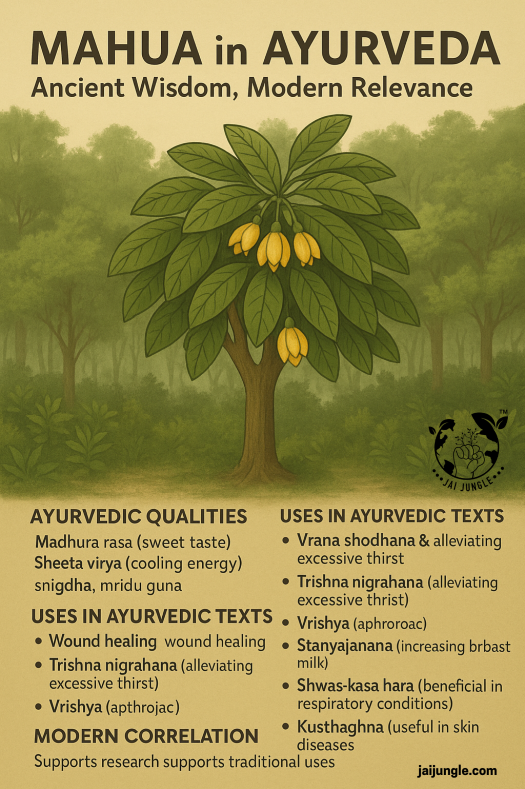Reintroducing an Ancient Healer
In Ayurveda, the Mahua tree (Madhuca longifolia)—known as Madhuka or Madhukari in Sanskrit—holds a respected place among forest-based medicinal plants. Mentioned in the Charaka Samhita and Sushruta Samhita, Mahua was valued for its madhura rasa (sweet taste), sheeta virya (cool potency), and nourishing, restorative effects.
Today, as interest in plant-based wellness rises, these ancient insights offer a valuable bridge between traditional medicine and modern phytotherapy.
Ayurvedic Pharmacology: Guna, Rasa, Virya and Vipaka
Ayurvedic texts describe Mahua’s attributes in precise energetic terms that govern how a substance acts on the body.
| Property | Sanskrit Term | Description | Functional Effect |
|---|---|---|---|
| Taste (Rasa) | Madhura rasa | Sweet taste | Nourishing, cooling, restorative |
| Qualities (Guna) | Snigdha, Mridu | Unctuous, soft | Lubricating, soothing to tissues |
| Potency (Virya) | Sheeta virya | Cooling energy | Calms heat, reduces inflammation |
| Post-digestive effect (Vipaka) | Madhura vipaka | Sweet after-taste | Builds strength, pacifies Pitta & Vata |
(Sources: Charaka Samhita Sutra 6.40; Sushruta Samhita Sutra 38; foodandnutritionjournal.org)
These properties explain why Mahua is both nutritive and sedative—able to pacify Pitta (fire) and Vata (air), while potentially aggravating Kapha (water/earth) if consumed in excess due to its heaviness and sweetness.
Classical Ayurvedic Uses and Therapeutic Indications
1. Vrana Shodhana and Ropana – Wound Cleansing and Healing
Mahua flowers and bark are used for cleaning and healing wounds. Decoctions or poultices relieve swelling and promote tissue repair (easyayurveda.com).
Modern correlation: Mahua extracts show antibacterial and wound-healing properties (ResearchGate, 2021).
2. Trishna Nigrahana – Relieving Thirst and Heat
Madhuka panaka (flower syrup) is prescribed to counter dehydration and fever heat. Ayurveda attributes this to its sheeta virya (cooling potency).
Modern view: acts as a natural oral rehydration drink, supplying sugars and fluids (foodandnutritionjournal.org).
3. Vrishya – Aphrodisiac and Vitality Tonic
Madhuka arishta (fermented Mahua preparation) was considered libido-enhancing. The flower’s nourishing and stress-relieving nature contributed to vitality (researchgate.net).
4. Stanyajanana – Galactagogue
Powdered Mahua flowers mixed with milk were advised for lactating mothers (researchgate.net). The energy-dense, mildly phytoestrogenic nature may support milk production.
5. Shwas-Kasa Hara – Respiratory Relief
Madhuka arishta was used in cough, bronchitis, and asthma (planetayurveda.com). Controlled fermentation yields mild expectorant effects, aligning with Mahua’s observed saponin content.
6. Kusthaghna and Twak Doshahara – Skin and Dermal Care
Mahua leaf or seed-oil paste is used for eczema, itching, and dermatitis (ajpsonline.com).
Seed oil’s emollient and antimicrobial actions explain its use as natural skin balm.
7. Mutrala – Diuretic and Urinary Support
Flower decoction aids urination and cools burning sensations, balancing Pitta in the urinary tract (researchgate.net).
8. Atisara and Raktapitta – Diarrhea and Bleeding Disorders
Astringent bark decoctions help control bleeding gums or uterine bleeding (easyayurveda.com).
Classical Formulations Featuring Mahua
| Formulation | Sanskrit / Common Name | Primary Action | Key References |
|---|---|---|---|
| Madhukadyarishta | Fermented tonic | Appetite & digestion enhancer | Bhavaprakasha Nighantu |
| Madhuka Taila | Medicated oil | Joint pain and skin therapy | Sushruta Samhita |
| Dashanga Lepa | Herbal wound paste | Ulcers & chronic sores | Ayurvedic Formulary of India |
| Tribal Remedies | Folk Ayurveda | Oil for piles, flower ghee for cracked feet | Lok Swasthya Parampara records |
These show how Mahua served in both formal Ayurvedic formulations and folk medicine traditions across India.
Bridging Ancient Texts and Modern Science
Modern phytochemical studies validate many of these classical insights:
| Traditional Claim | Modern Evidence | Mechanism Observed |
|---|---|---|
| Wound healing | Antioxidant & tissue repair activity | Phenolic compounds stimulate collagen |
| Cooling & thirst-relief | Lowers body temperature slightly | Electrolyte and sugar balance |
| Respiratory relief | Expectorant action | Saponins help expel mucus |
| Galactagogue | Nutrient-dense & phytoestrogenic | Enhances lactation nutritionally |
| Skin therapy | Antimicrobial & emollient effects | Fatty acids soften skin and reduce microbial load |
(Sources: foodandnutritionjournal.org; ajpsonline.com; ResearchGate 2021; ICAR Plant Metabolite Studies 2022)
Thus, Ayurveda’s observations about Mahua’s cooling, nourishing, and restorative energies find biochemical confirmation today.
Contemporary Ayurvedic Products and Practices
The revival of interest in forest-based botanicals has led to new Ayurveda-inspired formulations incorporating Mahua:
- Herbal teas and infusions: marketed for cooling, detoxifying, and calming effects.
- Ayurvedic churnas: laxative blends include Madhuka pushpa churna for gentle bowel regulation.
- Herbal syrups for cough and bronchitis: use Mahua extract for expectorant action.
- Post-natal nutrition supplements: modern formulations revisit stanyajanana uses for lactating mothers.
These adaptations reflect Ayurveda’s living tradition—ancient formulations interpreted for present-day needs.
Holistic Context in Ayurveda
Ayurveda treats Mahua as part of an integrated regimen rather than a stand-alone drug.
For weakness or debility (dhatu kshaya), Mahua flower nectar might be paired with milk and tonics like Ashwagandha.
For high Pitta fevers, Mahua drink is combined with sandalwood or vetiver for systemic cooling.
This illustrates Ayurveda’s emphasis on synergistic therapy—balancing body energies through food, herbs, and lifestyle.
Safety and Dosage Considerations
Classical texts caution that Mahua, being heavy (guru) and sweet, can increase Kapha if overused.
Recommended medicinal doses:
- Flower syrup: 10–20 mL diluted in water (coolant)
- Fermented arishta: 15–30 mL after meals (digestive tonic)
- Seed oil (external): applied topically for skin or joint relief
Overconsumption may lead to indigestion or lethargy; therefore, it is combined with digestive spices such as Trikatu (ginger, black pepper, long pepper) to balance heaviness.
Reviving Ancient Wisdom
Ayurveda’s portrayal of Mahua as Madhura, Sheeta, Snigdha—sweet, cooling, and unctuous—matches the modern understanding of it as a nutritive, anti-inflammatory, and restorative plant.
By re-evaluating traditional Mahua formulations through clinical and phytochemical research, India can harness a homegrown botanical resource to address common ailments naturally.
Mahua thus represents not only tribal and forest heritage but also Ayurveda’s enduring ecological intelligence—a healing system deeply attuned to local biodiversity.
Quick Reference Summary
| Aspect | Ayurvedic Interpretation | Modern Understanding |
|---|---|---|
| Energy profile | Sheeta virya (cooling) | Reduces inflammation, heat stress |
| Taste & effect | Madhura rasa (sweet) | Nutritive, restorative |
| Dosha impact | Pacifies Pitta & Vata | Calms stress and metabolic heat |
| Overuse effect | Increases Kapha | May cause heaviness |
| Major actions | Tonic, wound-healing, skin and respiratory support | Antioxidant, antimicrobial, expectorant |
References and Data Sources
- Charaka Samhita. (c. 200 BCE). Sutra Sthana 6.40 – Description of Madhura Rasa Dravya (Sweet-tasting Substances). Translated and edited by P. V. Sharma, Chaukhamba Orientalia, Varanasi.
- Sushruta Samhita. (c. 100 BCE). Sutra Sthana 38 – Pharmacological Properties of Cooling Herbs. Edited by G. D. Singhal, Chaukhamba Sanskrit Series Office, Varanasi.
- Bhavaprakasha Nighantu. (16th century CE). Madhuka Varga (Section on Mahua). Commentaries by K. C. Chunekar, Chaukhamba Bharati Academy, Lucknow.
- Food and Nutrition Journal. (2021). “Traditional Cooling Beverages in Ayurveda: Nutritional Evaluation of Madhuka Panaka.” Food and Nutrition Journal, Vol. 9 (3), pp. 145-152. https://foodandnutritionjournal.org
- Easy Ayurveda. (2020–2023). Articles: Madhuka – Madhuca longifolia Uses, Benefits, Dosage and Side Effects; Trishna Nigrahana Remedies in Ayurveda. https://easyayurveda.com
- Planet Ayurveda. (2021). Ayurvedic Herbs for Cough and Bronchitis – Role of Madhuka arishta. https://planetayurveda.com
- ResearchGate. (2021). “Ethnopharmacological and Biological Studies on Madhuca longifolia Flowers and Seed Oil.” https://researchgate.net
- AJP – Asian Journal of Pharmaceutical Sciences and Research. (2020). “Evaluation of Wound-Healing and Antimicrobial Activities of Madhuca longifolia Seed Oil.” ajpsonline.com https://ajpsonline.com
- IJSRT Journal. (2021). “Review on Madhuca longifolia as a Medicinal Plant in Ayurveda.” International Journal of Scientific Research and Technology. https://ijsrtjournal.com
- Ayurwiki and TrustHerb Databases. (2022). Materia Medica Summaries for Madhuka (Mahua). https://ayurwiki.org
- Deep Ayurveda. (2022). Madhuka Flower in Ayurvedic Formulations: Therapeutic Profile and Clinical Use. https://deepayurveda.com
- ICAR Plant Metabolite Studies. (2022). Phytochemical Profiling and Antioxidant Activity of Madhuca longifolia Flower Extracts. Indian Council of Agricultural Research, New Delhi.
- Lok Swasthya Parampara Programme. (2018). Documentation of Tribal Health Traditions in Central India – Mahua-Based Remedies. Ministry of AYUSH and FRLHT, Bengaluru.
- Ayurvedic Formulary of India. (2016 Edition). Ministry of AYUSH, Government of India, Vol. II, pp. 147-148 (Dashanga Lepa and Madhukadyarishta entries).
- Food and Nutrition Journal – Plant Metabolite Section. (2023). “Cooling and Antioxidant Mechanisms of Madhuca longifolia Flower Syrup.” Food and Nutrition Journal, Vol. 10 (1).

